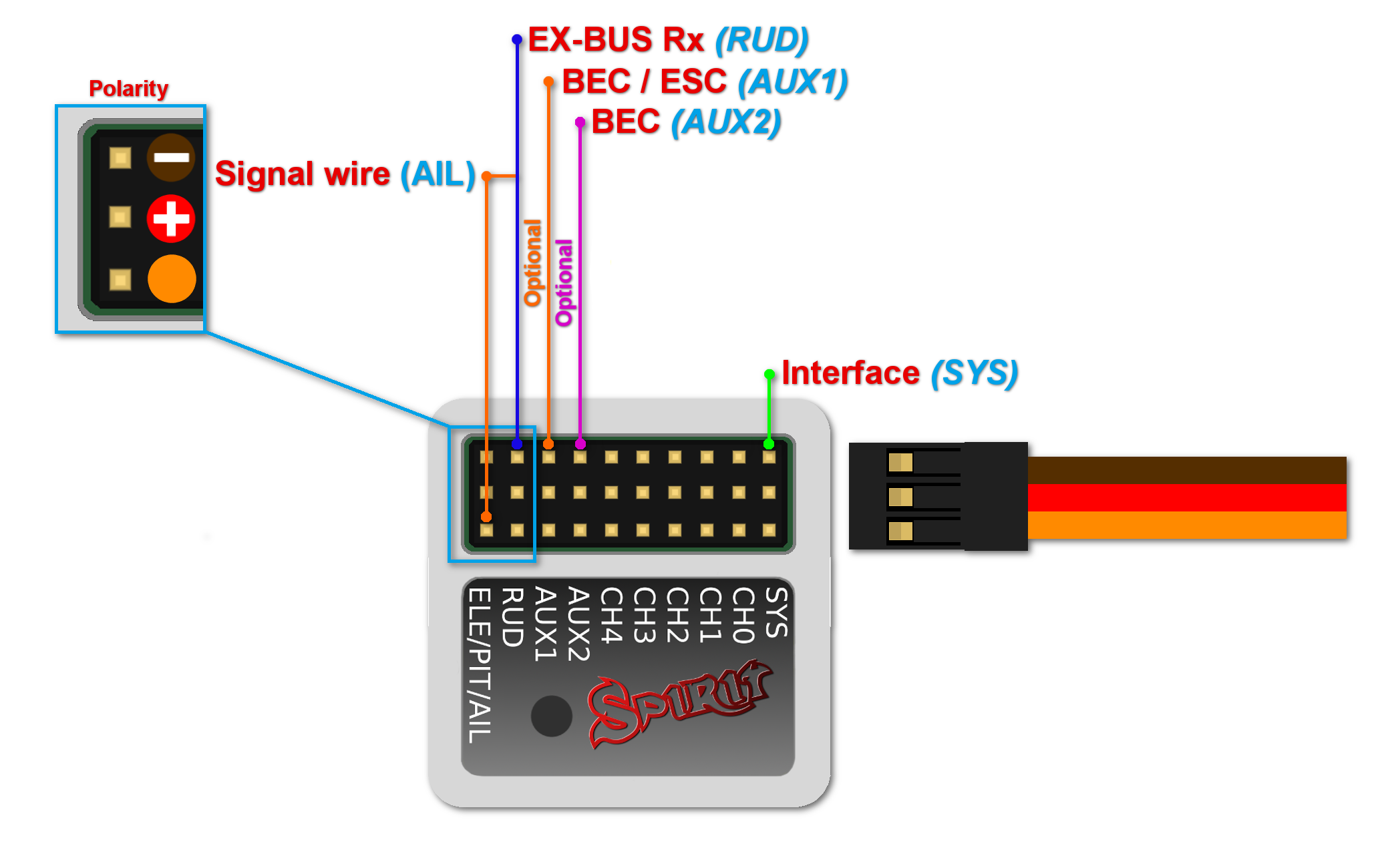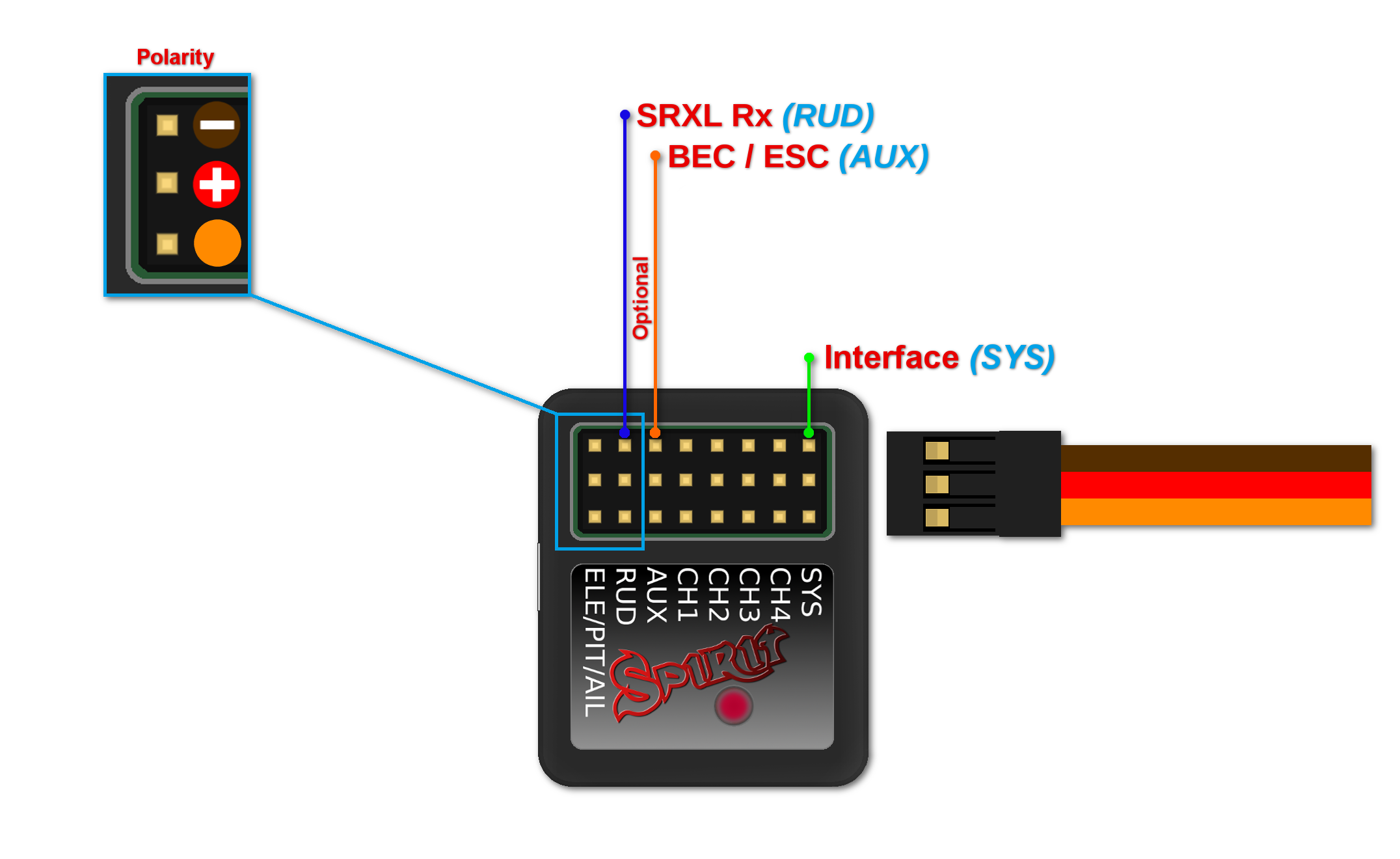Difference between revisions of "Wiring/fr"
(Created page with "Ne branchez jamais un connecteur d'alimentation sur les ports SYS et ELE/PIT/AIL.") |
|||
| Line 101: | Line 101: | ||
| − | ''' | + | '''Ne branchez jamais un connecteur d'alimentation sur les ports SYS et ELE/PIT/AIL.''' |
Revision as of 12:55, 20 September 2016
Le Spirit peut être utilisé comme un gyroscope dédié à l'anticouple ou bien comme un système flybarless. Le câblage du module dépend du type de récepteur utilisé.
NOTE
Le Spirit est pré-programmé pour utiliser des servos avec un neutre à 1520µs et une fréquence de 50Hz. Veuillez vous assurer que les paramètres de servos sont conformes à ceux spécifiés par le fabriquant.
Si le neutre d'un de vos servos est différent, comme 760µs, ne le connectez pas maintenant parce qu'il pourrait être endommagé.
Certains connecteurs ont des dimensions non standard qui pourraient gêner les connecteur adjacents. Nous recommendons dans ce cas de remplacer ces connecteurs non standards par des connecteurs de type JR ou Futaba.
Ne branchez jamais un connecteur pour alimenter le module dans les positions SYS ou ELE/PIT/TAIL. Vous risquez d'endommager le module.
Contents
1 GYROSCOPE AUTONOME ET BARRE DE BELL
Les possesseurs d'hélicoptères à barre de Bell peuvent utiliser le gyroscope à conservateur de cap, qui garde la direction de l'anti-couple donnée par l'émetteur quelques soient les effets du vent ou de forces extérieures.
Connectez le servo d'anti-couple au port "CH4" du module Spirit. Si vous utilisez aussi un récepteur standard, vous aurez besoin de connecter la voie GEAR (ou AUX) de votre récepteur au port AUX du module Spirit. Vous devrez aussi connecter le port RUD de votre récepteur au port RUD du module Spirit.
Même si vous avez un hélicoptère à barre de Bell, vous pouvez connecter le module de la même manière qu'avec un hélicoptère flybarless. Cela permet d'utiliser tout le potentiel du module comme la Stabilisation et le mode Sauvetage. Pour que ceci fonctionne correctement, il est nécessaire ce cocher "Flybar mechanic" dans l'onglet Stabi durant la configuration. Tous les autres paramètre peuvent être ajustés de la même façon que sur une tête flybarless.
2 FLYBARLESS
Les hélicoptères flybarless peuvent tirer partie de toutes les possibilités du module Spirit. Le Spirit va stabiliser le modèle sur tout les axes et le rendra aussi moins sensible au vent. Il étendra son temps de vol et augmentera son l'agilité. S'il est configuré correctement, le vol sera plus agréable ce qui vous donnera la confiance pour tenter des manoeuvre plus difficiles.
Les pales flybarless sont aussi différentes des pales conçues pour les modèles à barre de Bell. Pour de performance de vol optimum il est recommandé de les utiliser. Lors de l'utilisation du Spirit sur un système flybarless, tous les servos devraient être connectés aux position appropriées. Voir la description qui suit:
| Spirit |
| CH1 – Servo de Pas / Aileron |
| CH2 – Servo de profondeur |
| CH3 – Servo d'Aileron/Pas |
| CH4 – Servo d'anti-couple |
| Spirit Pro |
| CH1 – Servo de Pas / Aileron |
| CH2 – Servo de profondeur |
| CH3 – Servo d'Aileron / Pas |
| CH4 – Servo d'anti-couple |
| CH0 – Servo de cyclique auxiliaire (optionnel) pour les plateaux cyclique de type CCPM 90 |
NOTE
Les servos connectés à CH1 et CH3 dépendent de la configuration du plateau cyclique. Le servo d'Aileron est le plus souvent du côté droit, tandis que le servo de Pas est du côté gauche.
3 CONNECTION D'UN RECEPTEUR STANDARD (PWM)
Spirit – type de recepteur: PWM
Spirit Pro – type de recepteur: PWM
Pour les récepteurs standards, il est nécessaire d'utiliser 2 câbles normaux et un câble spécial. Les 3 connecteurs du câble spécial doivent être branchés sur le récepteur et l'autre côté sur le module.
Le module est alimenté par les deux câbles venant du récepteur connectés dans les ports AUX et RUD. Le câble des Gaz doit lui aussi être connecté au récepteur.
La manière la plus simple de commencer est de connecter le port RUD du module à la voie Rudder (anti-couple) du récepteur. Puis de continuer avec le port AUX du module, sur la voie du gain gyroscope du récepteur. Ensuite, connectez les voies Aileron, Profondeur, Pas (Aileron 2). Si vous n'êtes pas sûr de ma voie à utiliser, connectez un seul servo et alimentez le module pour vérifier si la connexion est correcte. Cette méthode peut être répétée pour chaque servo. L'onglet diagnostiques est aussi très utile.
Ne branchez jamais un connecteur d'alimentation sur les ports SYS et ELE/PIT/AIL.
4 CONNECTION OF SPEKTRUM DSM2/X SATELLITE
Spirit – receiver type: Spektrum DSM2/X
Spirit Pro – receiver type: Spektrum DSM2/X
Connection to a BEC is optional. If the model is powered by an external BEC, this must be connected to the RUD port. Also the power lead from the ESCs internal BEC must be disconnected.
To bind the satellites, insert a bind plug in the SYS port for DSM2 satellites or the ELE/PIT/AIL port for DSMX satellites. Power cycling the Spirit start the bind process. Once successfully bound, the STATUS LED will go out and the satellite LED will come on.
If the second satellite fails to bind, swap the satellites and repeat the bind process.
Be sure Receiver type in the software is configured to Spektrum DSM2/X or else binding process will not work. Never plug a connector for powering the unit to SYS or ELE/PIT/AIL positions.
5 CONNECTION OF FUTABA S-BUS RECEIVER
Spirit – receiver type: Futaba S-BUS
Spirit Pro – receiver type: Futaba S-BUS
Connection to a BEC is optional. For models of 500 size and larger it is recommended to use dual power supply cables due to the increased power consumption. That means besides the S-BUS cable, an additional power supply cable should be connected to the AUX port.
When using this type of receiver you can connect the throttle cable directly to the receiver. Alternatively, you can assign the throttle channel in the software and use the AUX as throttle output from the unit.
Never plug a connector for powering the unit to SYS or ELE/PIT/AIL ports.
6 CONNECTION OF PPM RECEIVER
Spirit – receiver type: PPM
Spirit Pro – receiver type: PPM
NOTE
Connection to a BEC is optional. For models of 500 size and larger it is recommended to use dual power supply cables due to the increased power consumption. That means besides the communication cable, an additional power supply cable should be connected to the AUX port.
When using this type of receiver you can connect the throttle cable directly to the receiver. Alternatively, you can assign the throttle channel in the software and use the AUX as throttle output from the unit.
Never plug a connector for powering the unit to SYS or ELE/PIT/AIL ports.
7 CONNECTION OF JETI EX BUS RECEIVER
Spirit – receiver type: Jeti EX Bus
Spirit Pro – receiver type: Jeti EX Bus
This connection type now supports the new integration with JETI Model transmitters. You can now fully configure the Spirit unit remotely through the JETI Model transmitter.
Remember to configure the receiver type through the software or the integration will not work. Also, it is necessary to download Spirit.bin file from the website. Move the file to the Devices directory in the SD card of your transmitter.
NOTE
Connection to a BEC is optional. For models of 500 size and larger it is recommended to use dual power supply cables due to the increased power consumption. That means besides the EX Bus cable, an additional power supply cable should be connected to the AUX port.
When using this type of receiver you can connect the throttle cable directly to the receiver. Alternatively, you can assign the throttle channel in the software and use the AUX as throttle output from the unit.
A special cable is needed to enable this communication.
Never plug a connector for powering the unit to SYS or ELE/PIT/AIL ports.
8 CONNECTION OF SRXL/SUMD RECEIVER
Spirit – receiver type: SRXL/SUMD
Spirit Pro – receiver type: SRXL/SUMD
NOTE
Connection to a BEC is optional. For models of 500 size and larger it is recommended to use dual power supply cables due to the increased power consumption. That means besides the communication cable, an additional power supply cable should be connected to the AUX port.
This protocol family can work with a wide range of receivers.
Thus you can use Multiplex SRXL, BeastX SRXL, Graupner SUMD, Jeti UDI, Spektrum SRXL and more.
When using this type of receiver you can connect the throttle cable directly to the receiver. Alternatively, you can assign the throttle channel in the software and use the AUX as throttle output from the unit.
Never plug a connector for powering the unit to SYS or ELE/PIT/AIL ports.
9 CONNECTOR ORIENTATION
All cables connected to the unit must be oriented so that the signal wire (Lightest color wire) is closer to the connector pin label, towards the center of the unit. This orients the negative (darkest color wire) toward the edge of the unit.











